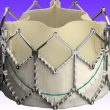Chronic Lung Disease often affects patients with severe aortic stenosis undergoing transcatheter aortic valve replacement (TAVR) or surgery. In fact, this is why patients with lung disease are often deemed inoperable and prescribed TAVR. This is the first time the benefit of TAVR has been assessed in this group of patients, for symptoms of these conditions can...
Post TAVR Long Term Outcomes in Patients with Chronic Inflammatory Disease
Patients suffering from immune-mediated chronic inflammatory disease (CID) face a high risk of developing heart disease, including aortic valve disease. Inflammatory vascular disease when triggered by an autoimmune condition, can prompt a harmful response leading to valve degeneration, with increased calcification and fibrosis, and the associated progression of stenosis, failure or both. Prior research has...
Chronic Inflammation, Coronary Artery Disease and Cancer: Same Coin, Different Sides
Low grade inflammation shown by elevated plasma concentrations of high-sensitive C-reactive protein are a risk factor for coronary artery disease (CAD) patients. There is also evidence to support low grade inflammation could be related to higher risk of cancer. This prospective study evaluated the relation between low grade systemic inflammation and the risk of cancer in...
We Should Start Considering Pulmonary Hypertension After TAVR
Pulmonary hypertension is associated with higher mortality after both aortic valve replacement and transcatheter aortic valve replacement (TAVR). This is a dynamic phenomenon, and what happens after TAVR —during the periprocedure— and its impact are yet to be evaluated. Researchers conducted a subanalysis of the Japanese OCEAN TAVI Registry, which included 1872 patients who were divided...
Surgical Bioprosthesis Deterioration: Is the Valve-in-Valve Technique a Good Option?
The use of surgical bioprostheses has significantly increased, and while they last 15 years or more, in cases where they fail (usually due to stenosis), the decision-making process is challenging. Transcatheter aortic valve replacement (TAVR) is a good alternative for this situation, although information on the subject matter is still scarce. Currently, the only available...
NT-proBNP Level Predicts Who May Benefit From TAVR
A normal or (on the other end) a very high level of NT-proBNP should make us look for a cause other than aortic stenosis. If aortic stenosis is not the culprit of the clinical case, a transcatheter aortic valve replacement (TAVR) will hardly benefit these patients. These data come from a recently published paper in...
Antianginal Medication Before and After Rechanneling
Escalation or de-escalation of antianginal medication was less common than treatment continuation without change after a chronic total occlusion rechanneling, with little variation according to the site. Further research is needed to identify patients who would benefit (or not) from these drugs and to develop strategies to adjust treatment during follow-up. This work basically tells...
Complex PCI: DAPT defining factor?
Courtesy of Dr. Alejandro Lakowsky, MTSAC. The Journal of the American College of Cardiology (JACC) has recently published a study on the role of coronary anatomy and PCI technical difficulty in the cost benefit ratio of prolonged vs. short post procedural DAPT. This study was carried out by Robert Yeh, Laura Mauri and the DAPT trial...
Balloon Angioplasty: A Reasonable Plan B for Chronic Thromboembolic Hypertension
Thromboembolic pulmonary hypertension is caused by pulmonary artery stenosis caused by organized thrombi. The only treatment potentially healing for this disease is surgical thrombectomy. However, patients with lesions in very peripheral branches or high surgical risk patients with comorbidities might benefit from a plan B, such as balloon pulmonary angioplasty. The percentage of patients with chronic...
Angioplasty Complexity May Define the Duration of Dual Antiplatelet Therapy
The DAPT study concluded that continued thienopyridine plus aspirin beyond a year after coronary angioplasty is associated with a decrease in the rate of stent thrombosis and major cardiovascular events. In contrast, there is a significant increase in moderate to severe bleeding when compared with continued aspirin alone. Based on the outcomes of this and...
- 1
- 2








